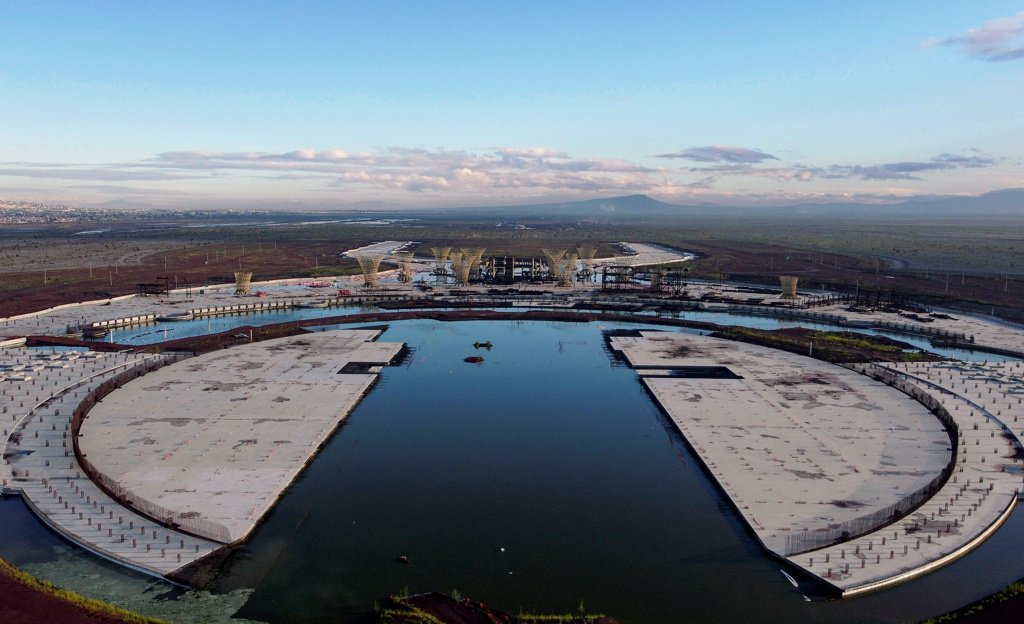How a ruined airport in Mexico is to become an eco-park
The story begins in the 16th century in a region where Mexico’s capital is today: A blooming lake landscape around Lake Texcoco, home of the Aztecs – the capital is called Tenochtitlan – is almost completely destroyed by Spanish immigrants. The conquerors drained the wetland, tapped tributaries for agriculture and paved the lake bed. Mexico City is created, today a metropolis for more than 21 million people.
Advertisement
When construction of the Nuevo Aeropuerto Internacional de la Ciudad de México (NAICM) airport, which cost 13 billion dollars, began in 2015, Lake Texcoco threatened to disappear completely. But things are different.
Airport project stopped
President Andrés Manuel López Obrador halted construction of the airport just a few weeks after taking office at the end of 2018. During his election campaign, he berated the project management for excessive spending and corruption. In a referendum initiated by Obrador’s party after the elections, the population also voted for the airport to be abolished.
In the vast, strangely empty landscape larger than Paris, surrounded by the capital’s foothills, one of the largest eco-parks in the world is now to be created, “a new Tenochtitlan,” says Obrador. He hires Iñaki Echeverria, a Mexican architect and landscape designer, to oversee the planning. Echeverria has worked to restore the site for more than two decades. The budget: one billion dollars.
The former wetlands are overgrown and are to be wetted again.
(Image: ddp)
solution to water problems
Advertisement
Among other things, artificial lakes and new habitats for a wide variety of animal species are now to be created. Echeverria’s team also hopes that the park can also contribute to economic development: New nurseries, for example, are intended to revive endangered cultural practices for growing native plants – such as the harvesting of spirulina algae.
In addition, the park could solve two major problems in the nearby Mexican capital. The revitalized lake landscape is intended to serve as an overflow basin and thus prevent flooding of the sealed urban areas. From the ponds, in turn, the water can seep back into the aquifers, which should slow down the sinking of the capital – and thus a fatal development. Because the city was built on a gigantic, but dramatically shrinking underground groundwater reservoir. Parts of Texcoco Park are sinking at a rate of 20 to 40 centimeters per year. The streets in the nearby city center are rippling because of the erratic subsidence.
The car is the linchpin of today’s mobility. But CO2 emissions and congested roads make a discussion about the future of mobility all the more urgent. This is what the new issue of MIT Technology Review deals with. Highlights from the magazine:
Renaturation 2.0
For a long time it was common to restore an area to its original state in renaturation projects, without considering the needs of the local people and the history of the region. This is no longer up-to-date, says Eric Higgs, professor of environmental planning at Canada’s University of Victoria. Because more and more frequently it simply does not succeed, the man-made destruction is too great.
He therefore advocates not concealing an area’s past, even if it was once home to dirty industry and colonial expropriation. As an example, he cites Rocky Flats, a nuclear weapons research facility near Denver that now has protected status. “To say: ‘Look at this beautiful nature reserve’ without understanding its complicated and multi-layered history is pointless,” says the environmental expert.
How the story of the Texcoco Park will continue has not yet been decided. The people on site complain about the lack of transparency in the process. The park is currently surrounded by a kilometer-long border fence guarded by guards in military uniforms.
López Obrador’s term ends in 2024. The project is inaccessible to the public and is still subject to conflict. Plans for Lake Texcoco’s rebirth could yet come to fruition.
Read MIT Technology Review here:
(Older brother)
To home page
